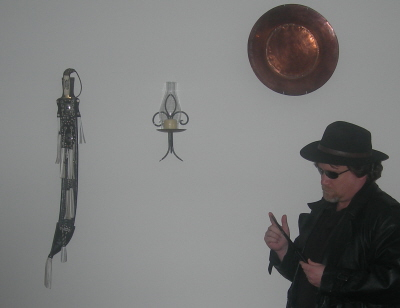|
About This Author
Come closer.
|
Complex Numbers
Complex Numbers
A complex number is expressed in the standard form a + bi, where a and b are real numbers and i is defined by i^2 = -1 (that is, i is the square root of -1). For example, 3 + 2i is a complex number.
The bi term is often referred to as an imaginary number (though this may be misleading, as it is no more "imaginary" than the symbolic abstractions we know as the "real" numbers). Thus, every complex number has a real part, a, and an imaginary part, bi.
Complex numbers are often represented on a graph known as the "complex plane," where the horizontal axis represents the infinity of real numbers, and the vertical axis represents the infinity of imaginary numbers. Thus, each complex number has a unique representation on the complex plane: some closer to real; others, more imaginary. If a = b, the number is equal parts real and imaginary.
Very simple transformations applied to numbers in the complex plane can lead to fractal structures of enormous intricacy and astonishing beauty.
| |
Today we're talking about one of my favorite subjects.
“Yeast has always been the most magical part of brewing,” says Jeff Mello. “It’s the only ingredient that’s still alive when it’s used, and you only have so much control over it.”
Magic, indeed. I'm sure before Leeuwenhoek (not a band name, but the scientist), before we knew what microorganisms really were, it must have seemed magical and/or divine. (Incidentally, Leeuwenhoek came from a family of brewers.  ) )
Also, with a name like Jeff Mello, if he doesn't call one of the yeast strains "Mello Yello," I shall be sorely disappointed.
In 2013, Mello was a homebrewer who had just left nonprofit fundraising. But a trip to Brussels, Belgium, launched him on a new career in yeast innovation.
Lucky stiff actually getting to go to Belgium.
On his trip, Mello was inspired by local brewers’ use of traditional yeasts, techniques, and equipment. “The more I looked into yeast like Brettanomyces or bacteria like Pediococcus,” he says, mentioning two ingredients familiar to brewers, “it became clear that I wanted to pull back the veil on these wild microbes and figure out new ways they could be used for beer making.”
It's very likely (or so I've heard) that the earliest beers used whatever yeast was floating around. Over time, strains were cultivated (even before the whole microscope thing) and standardized. Belgian beers tend to use a different strain than German ones, accounting for the different taste of each. But there's no reason why other yeasts shouldn't be experimented with.
When he got home, Mello set out a mason jar behind his house in Arlington, Virginia...
Anyone familiar with the DC area should recognize that this is a badly missed opportunity for a pun.
Lacking a scientific background or industry experience, Mello describes many early projects as “total disasters” covered with mold.
Hence the term "experiment." Sometimes experiments fail.
While Mello has been a catalyst in expanding interest in new yeasts, Bootleg Biology’s signature initiative, the Local Yeast Project, is only possible thanks to the wider brewing community.
There are, last I checked, around 10,000 breweries in the US alone (the number keeps changing; I haven't checked in a while and I can't be arsed to now, but that one's in the ballpark and it's got a nice bunch of zeros in it). Oddly, most of them aren't cutthroat competitors; they just like making beer. Problem is, with that kind of market saturation, you still have to find a way to stand out. For a while there, the way to stand out was to get your IBUs up as high as possible. Those were dark days. Fortunately, the overhopped bitter beer craze seems to have died down, and they're messing around with a lot more variety.
And to achieve some of that variety sometimes means using different grains, hops, and yeasts.
Homebrewer Harry Peck, who has contributed to the yeast bank, used Bootleg’s kit to capture two strains from the air in his Garfield, New Jersey, backyard. He then made two beers with the same ingredients—except each featured one of the strains. By comparing them, he learned that one of his strains tasted more of bananas while the other featured a taste of clove.
Generally, banana and clove taste overtones are associated with Belgian beers. However, too much banana flavor can be a sign of poor brewing practice.
Mello also sees the project as a way to help brewers succeed in the industry. He notes that local yeasts, when paired with other local ingredients, can help create a local flavor, giving breweries an edge on competition. “At some point, if you focus on local ingredients, you are creating an identity that can’t be recreated, you know? And to me, that’s a no-brainer way of standing out in that way.”
Remember I said there are thousands of breweries? Well, very few of them distribute nationwide -- ones like Samuel Adams, Sierra Nevada, and New Belgium. There are some considered "regional" that can only be found in a limited area. But the vast majority are local, usually set up by some dude who got into homebrewing and figured he could maybe make some money at it. That, I presume, is the target audience.
This is the case with Place of Origin, a beer made by Harding House, a Nashville brewery that passionately supports local farmers and food traditions. Its brewers challenge themselves to only brew seasonally and include a local ingredient in every batch of beer.
Now, there's something to be said for being able to source ingredients from all over the world. It's one of the few benefits of living in the final days of a declining civilization, along with global beer itself. But I do recognize the benefit of staying local, too.
There's a term generally only used in oenology: terroir. It describes the taste derived from the soil of the grapevines' roots. It's most noticeable in lighter wines; with Vouvray, for example, which is a chenin blanc, the best ones actually have undertones of the ancient soil of le val de Loire. You don't get that as much with beer, or with large-batch wines which are designed for consistency. You're not going to get much terroir from the grains used for the malt, but it seems to me that you can get the same kind of effect with these local yeasts.
Now if only I could get out of here again and try a few... |
© Copyright 2025 Robert Waltz (UN: cathartes02 at Writing.Com). All rights reserved.
Robert Waltz has granted InkSpot.Com, its affiliates and its syndicates non-exclusive rights to display this work.
|

